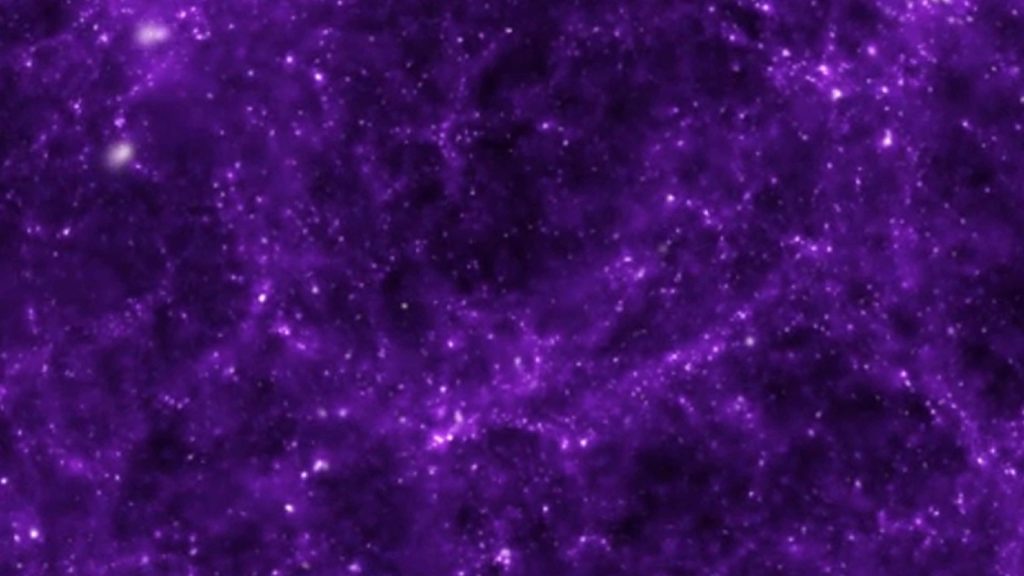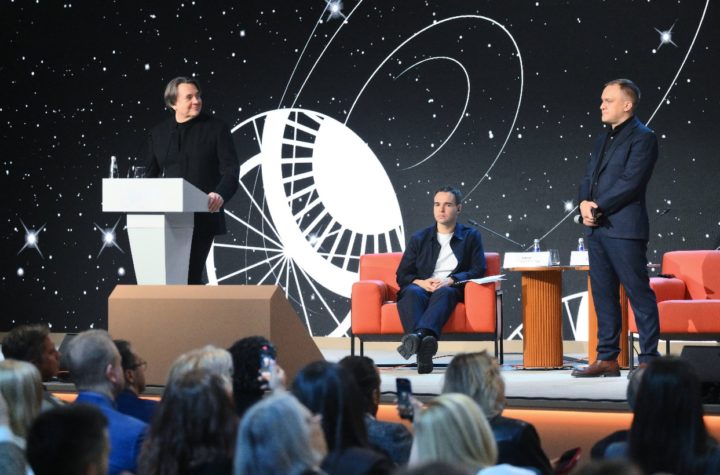
Илуструјте тамну енергију. Заслуге: Визуелизација Франка Самерса, Научни институт за свемирски телескоп. Симулација Мартина Вајта, УЦ Беркли и Ларса Хернквиста, Универзитета Харвард
Може ли се једна од највећих мистерија у астрофизици решити парафразирањем теорије гравитације Алберта Ајнштајна? Не још, према новој студији коју је коаутор[{“ attribute=““>NASA scientists.
The universe is expanding at an accelerating rate, and physicists don’t know why. This phenomenon seems to contradict everything scientists understand about gravity’s effect on the cosmos: It’s as if you threw an apple in the air and instead of coming back down, it continued upward, faster and faster. The cause of the cosmic acceleration, dubbed dark energy, remains a mystery.
A new study marks the latest effort to determine whether this is all simply a misunderstanding: that expectations for how gravity works at the scale of the entire universe are flawed or incomplete. This potential misunderstanding might help researchers explain dark energy. However, the study – one of the most precise tests yet of Albert Einstein’s theory of gravity at cosmic scales – finds that the current understanding still appears to be correct. The study was from the international Dark Energy Survey, using the Victor M. Blanco 4-meter Telescope in Chile.
The results, authored by a group of scientists that includes some from NASA’s Jet Propulsion Laboratory (JPL), were presented Wednesday, August 24, at the International Conference on Particle Physics and Cosmology (COSMO’22) in Rio de Janeiro. The work helps set the stage for two upcoming space telescopes that will probe our understanding of gravity with even higher precision than the new study and perhaps finally solve the mystery.

This image – the first released from NASA’s James Webb Space Telescope – shows the galaxy cluster SMACS 0723. Some of the galaxies appear smeared or stretched due to a phenomenon called gravitational lensing. This effect can help scientists map the presence of dark matter in the universe. Credit: NASA, ESA, CSA, and STScI
More than a century ago, Albert Einstein developed his Theory of General Relativity to describe gravity. Thus far it has accurately predicted everything from the orbit of Mercury to the existence of black holes. But some scientists have argued that if this theory can’t explain dark energy, then maybe they need to modify some of its equations or add new components.
To find out if that’s the case, members of the Dark Energy Survey looked for evidence that gravity’s strength has varied throughout the universe’s history or over cosmic distances. A positive finding would indicate that Einstein’s theory is incomplete, which might help explain the universe’s accelerating expansion. They also examined data from other telescopes in addition to Blanco, including the ESA (European Space Agency) Planck satellite, and reached the same conclusion.
Einstein’s theory still works, according to the study. So no there’s no explanation for dark energy yet. However, this research will feed into two upcoming missions: ESA’s Euclid mission, slated for launch no earlier than 2023, which has contributions from NASA; and NASA’s Nancy Grace Roman Space Telescope, targeted for launch no later than May 2027. Both telescopes will search for changes in the strength of gravity over time or distance.
Blurred Vision
How do scientists know what happened in the universe’s past? By looking at distant objects. A light-year is a measure of the distance light can travel in a year (about 6 trillion miles, or about 9.5 trillion kilometers). That means an object one light-year away appears to us as it was one year ago, when the light first left the object. And galaxies billions of light-years away appear to us as they did billions of years ago. The new study looked at galaxies stretching back about 5 billion years in the past. Euclid will peer 8 billion years into the past, and Roman will look back 11 billion years.
The galaxies themselves don’t reveal the strength of gravity, but how they look when viewed from Earth does. Most matter in our universe is dark matter, which does not emit, reflect, or otherwise interact with light. While physicists don’t know what it’s made of, they know it’s there, because its gravity gives it away: Large reservoirs of dark matter in our universe warp space itself. As light travels through space, it encounters these portions of warped space, causing images of distant galaxies to appear curved or smeared. This was on display in one of first images released from NASA’s James Webb Space Telescope.
хттпс://ввв.иоутубе.цом/ватцх?в=оН4СЕФИМЕО0
Овај видео објашњава феномен који се зове гравитационо сочиво, због чега слике галаксија изгледају изобличене или замрљане. Ово изобличење је узроковано гравитацијом, а научници могу да искористе ефекат да открију тамну материју, која не емитује и не рефлектује светлост. Заслуге: НАСА-ин центар за свемирске летове Годард
Научници из истраживања Дарк Енерги Сурвеи гледају слике галаксија у потрази за суптилнијим изобличењима због простора савијања тамне материје, ефекта који се назива слабим гравитационо сочиво. Сила гравитације одређује величину и дистрибуцију структура тамне материје, а величина и дистрибуција, заузврат, одређују колико нам ове галаксије изгледају искривљено. Овако слике могу открити силу гравитације на различитим удаљеностима од Земље иу удаљеним временима кроз историју универзума. Група је сада измерила облике више од 100 милиона галаксија, а до сада се запажања поклапају са оним што је Ајнштајнова теорија предвидела.
„Још увек има простора за оспоравање Ајнштајнове теорије гравитације, пошто мерења постају тачнија“, рекла је коауторка студије Агнес Ферти, која је спровела истраживање као постдокторски истраживач на ЈПЛ. „Али имамо још много тога да урадимо пре него што будемо спремни за Еуклида и Романа. Зато је императив да наставимо да сарађујемо са научницима широм света на овом проблему као што смо радили са истраживањем тамне енергије.“
Референца: „Резултати трећегодишњег истраживања тамне енергије: ограничења проширења за ΛЦДМ са слабим сочивима и галактичким кластерима“ од стране ДЕС Цоллаборатион: ТМЦ Абботт, М. Агуена, А. Аларцон, О. Алвес, А. Амон, Ј. Аннис, С. Авила, Д. Бацон, Е. Бактер, К. Бецхтол, М. Р. Бецкер, Г. М. Бернстеин, С. Биррер, Ј. Блазек, С. Боцкует, А. Брандао-Соуза, С. Л. Бридле, Д. Броокс, Д. Л. Бурке, Х. Цамацхо , а. Цампос, А.; Царнеиро-Роусселл, М. Царрасцо-Кинде, Ј. Царретеро, Ф.Ј. Цастандер, Р. Цавтхон, Ц. Цханг, А. Цхен, Р. Цхен, А. Цхои, Ц. Цонсуллис, Ј. Цордеро, М. Цостанзи, М. Цроцце, ЛН да Цоста, МЕС Переира, Ц. Давис, Т.М. Давис, Ј. ДеРосе, С. Десаи, Е. Ди Валентино, Х.Т. Диехл, С. Доделсон, П. Доел, Ц. Доук, А. Дрлица-Вагнер, К. Ецкерт, Т. Ф. Еифлер, Ф. Елснер, Ј. Елвин-Пооле, С. Еверетт, Кс. Фанг, А. Фарахи, И. Ферреро, А. Ферте, Б. Флаугхер, П. Фосалба, Д. Фриедел, О. Фриедрицх, Ј. Фриеман, Ј. Гарциа-Беллидо, М. Гатти, Л. Гиани, Т. Гианнантонио, Г. Гианнини, Д. Груен, Р. Р. Груендл, Ј. Гсцхвенд, Г. Гутиеррез , Н. Хаммос, И. Харрисон, В. Г. Хартлеи, К. Хернер, СР Хинтон, ДЛ; Хонсхед, Х. Хуанг, М. Хоф, де Хуттерер, Б. Јане, Д. Ј. Јамес, М. Јарвис, Н. Јеффреи, Т. Гелтима, А. Ковачс, Цросс, К. Цохн, Н.; Куропаткин, О. Лахав, С.; Лее, П.-Ф. Леггетт, Б. Лемус, ЦД Леонард, АР Лидделл, М. Лима, Х. Линн, Н. МцЦран, Ј.Л. Марсхалл, Ј. МцЦуллоугх, Ј. Мина Фернандез, Ф. Минанто, Р. Микел, В. Миранда, Ј. Ј. Мохр, Ј. Муир, Ј. Милес, С. Надтхор, А. Наварро-Алсина, РЦ Ницолл, РЛЦ Уганда, И. Аомори, А. Палмис, С Пандеи, И Парк, М Патерно, Ф Паз-Цхинцхон, ВГ Перцивал, А Перез, АА Плазас Малагон, А Буридон, Ј Пратт, М Равери, М Родригуез-Монрои, Б Рогозински, РП Роллинс, АК Ромер Родман, А. Р. Росенфелд, А. Ј. Росс, А. Рикофф и С. Родман. Саморов, Ц. Санцхез, Е. Санцхез, Ј. Санцхез и др. , М. Смитх, М. Соарес-Сантос, Е. Суцхита, М. Таббутт, Г. Тарле, Д. Тхомас, Ц. То, А. Троја, М. А. Трокел, И. Тутусаус, Т. Н. Варга, М. Винцензи, АР Валкер, Н. Вевердицк, Р.Х. Вецхлер, Ј. Вхеелер, П. Ианни, П. Иин, И. Зханг и Ј. Зонтз, 12. јул 2022., доступно овдје. Астрофизика > Космологија и негалактичка астрофизика.
арКсив: 2207.05766

„Љубитељ пива. Предан научник поп културе. Нинџа кафе. Зли љубитељ зомбија. Организатор.“





/cdn.vox-cdn.com/uploads/chorus_asset/file/25594197/Genki_TurboCharger_Hero.jpg)


More Stories
Када ће астронаути лансирати?
Према фосилима, праисторијску морску краву појели су крокодил и ајкула
Федерална управа за ваздухопловство захтева истрагу о неуспешном слетању ракете Фалцон 9 компаније СпацеКс